Fee Issues in the Process of Investing in Funds
People who have bought funds should know that fees are charged when buying funds. Today, I’ll organize some questions about fund fees. The following content is just what I’ve learned, and I can’t guarantee its authenticity. You need to distinguish it by yourself.
Special note: A lot of content in this blog refers to the book “Investing Regularly for Ten Years to Achieve Financial Freedom” by Ding Da. I highly recommend you to read it.
I don’t know if there are people like me who used to think that when buying funds on platforms like Tiantian Fund, there’s no need to pay too much attention to fee issues. Because the current fee rates are already very low compared to buying funds in banks in the past, and the differences among them are not significant, so there’s no need to spend time researching.
But in fact, there are still quite big differences. A 0.5% difference in the total annual fee rate between two funds may not seem like much. However, if you invest for 5 years, the difference will be 2.5%. This 2.5% may not sound like a lot, but the long - term annualized return in a mature financial market is only about 8%. By comparison, a 2.5% return is quite可观. And this 2.5% return can be earned just by taking a little look at the name of the fund when buying it. Why not do it?
What Fees Are Involved in Buying Funds
When we buy funds, we generally encounter the following 5 types of fees:
Subscription Fee:
The subscription fee is a fee paid to the fund management company when you buy a fund, usually a percentage of the investment amount. For example, if you invest 10,000 yuan and the subscription fee is 1%, then you need to pay 100 yuan as the subscription fee. But it’s worth noting that in the Chinese market, in recent years, many stock or hybrid funds have waived the subscription fee.Redemption Fee:
When you want to sell fund shares, you may need to pay a redemption fee, which is also a part of the investment amount. Its main purpose is to prevent short - term trading behavior. Therefore, there are usually differential charges based on the holding period. That is, the shorter the holding time, the higher the redemption fee rate. For example, a certain fund stipulates that if you redeem within 3 months of holding, a 1.5% redemption fee will be charged, while if you redeem after more than 1 year, the redemption fee will be reduced to 0.25%.Management Fee:
This is a fee calculated and extracted by the fund company based on the net value of the entrusted assets, used to pay the daily operation and management expenses of the fund manager.Custodian Fee:
The custodian bank charges the fund company an annual fee based on the total amount of the fund assets, and this is the custodian fee.Performance Fee:
For some enhanced index funds or private equity funds, if the fund manager can outperform the reference benchmark, a portion can be taken as a performance reward.
The fifth one, “Performance Fee”, is less commonly encountered and will not be discussed.
Subscription Fee
The subscription fee is the fee paid when buying a fund. This fee is a one - time charge, only charged once when buying, not annually.
When buying funds in banks, this fee is generally 1% or 1.5%, which is quite expensive.
But now, on online sales platforms like Tiantian Fund and Alipay’s Ant Fund, this fee is discounted by 10%, and most are only 0.1%. There are even some funds that do not charge the subscription fee.
The subscription fees of many funds are related to the subscription amount. The more you subscribe, the lower the fee rate.
The following picture is a screenshot of the subscription fee description of Xingquan CSI 800 Six - Month Holding Index A (010673) on Tiantian Fund:
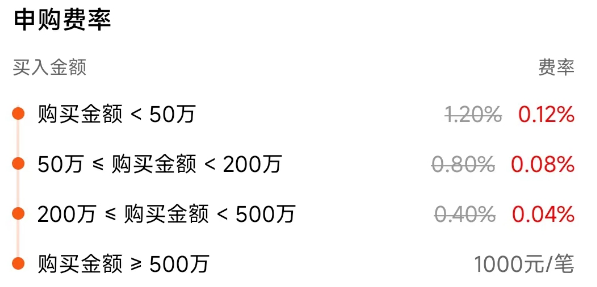
As you can see, the fee rates are different for different subscription amounts. But for most ordinary investors (like me), they are all in the first tier.
Generally speaking, since this fee is a one - time charge and there is only about a 0.1% difference due to the 10% discount on online sales platforms, the subscription fee doesn’t need to be paid too much attention.
Redemption Fee
The redemption fee is the fee charged when selling a fund. This fee is also a one - time charge.
Generally, the redemption fee is related to the holding time of the fund. Some important time nodes are 7 days, 30 days, 180 days, and 365 days.
If the holding time of the fund is less than 7 days, a punitive fee may be charged, with a fee rate of 1.5%. This is quite a significant amount.
I buy funds through regular investment and never do short - term trading, so I don’t have this problem. But for novices or ultra - short - term traders, this fee needs to be paid special attention. Otherwise, you’ll lose 1.5% of your money for no reason when buying and selling.
The two time nodes of 30 days and 180 days are not as special as 7 days. But many fund companies will use 30 days and 180 days as critical points to reduce the redemption fee.
365 days is also a relatively special time node for the redemption fee. In order to encourage investors to make long - term investments, many funds do not charge redemption fees for selling behaviors with a holding time of more than 365 days. This is equivalent to saving a sum of money, which becomes our profit.
Except for the 7 - day time node, the time points of 30 days, 180 days, and 365 days are not absolute. For example, there are also funds that require a holding time of more than 730 days to waive the redemption fee. Each fund is different.
The following are the redemption fee rate tables of Xingquan CSI 800 Six - Month Holding Index A and E Fund CSI 300 ETF Link A.
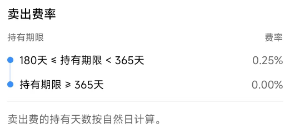
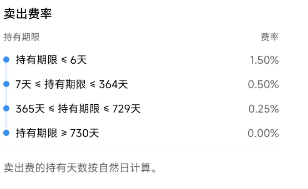
Summary: When selling funds, try to avoid holding for less than 7 days, otherwise, a 1.5% punitive redemption fee will be charged. If possible, try to make long - term investments. Holding for about 365 days can often exempt the redemption fee, turning this fee into our profit.
Management Fee and Custodian Fee
The management fee and custodian fee are often combined and charged as “fund operation fees”.
This fee is often the part with the biggest difference in the whole process of buying and selling funds.
Fund operation fees are generally calculated by an annual fee rate and deducted according to the actual number of holding days. That is to say, it is not a one - time charge!
And the fee rate is often quite high, ranging from 0 to 2%. And it is charged every year, which can lead to a large difference in returns.
Suppose the operation fee rate of a fund is 1.5% per year. If you hold it for 5 years, you need to pay 7.5% in fees! It’s equivalent to paying 7,500 yuan in fees for a 100,000 - yuan investment in this fund in 5 years! It’s not certain whether you can earn 7,500 yuan in 5 years, but you still have to pay so many fees. And this fee also needs to be paid when the fund is in a loss state.
The following are the operation fee rate situations of two funds for your comparison.
Operation Fee Rate of China Europe Medical Innovation Stock C
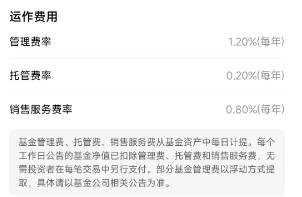
Operation Fee Rate of Tianhong CSI Medicine 100A
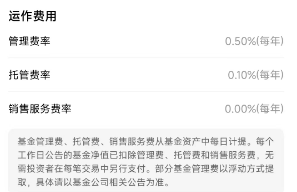
As you can see, although both are funds related to the medical industry, the operation fee rate difference is 0.6%, and in 5 years, the difference is 3%, which is quite a lot.
I haven’t made a detailed statistics, but from the funds I’ve seen, the operation fees of non - index funds are generally higher than those of index funds.
Differences among Class A, Class B, and Class C Funds
Class A funds are front - end fee - charging funds, and the subscription fee is charged一次性 when subscribing. You can refer to the previous content for the calculation method of the subscription fee.
One advantage of Class A funds is that if you sell them after holding for a relatively short time (such as 185 days), no redemption fee will be charged.
Class B funds are back - end fee - charging funds, and the sales service fee is charged when redeeming.
The subscription fee rate of Class B funds is 0, but a redemption fee of 1 - 3% will be charged. When Class B funds are sold after holding for a long time (such as 730 days), no redemption fee will be charged either. But generally speaking, the requirement for the holding time is longer than that of Class A.
Class C funds are sales service fee (that is, operation fee) funds. No subscription fee or redemption fee is charged when subscribing and redeeming, but a sales service fee will be charged from the fund assets. The sales service fee is generally charged as a certain percentage of the fund asset scale, and it is charged once a day.
However, there are usually certain conditions for Class C funds not to charge the redemption fee. For example, the holding time is required to be more than 30 days. This condition is relatively simple and easy to meet.
Since online sales platforms like Tiantian Fund now offer a 10% discount on subscription fees, the difference between Class A and Class B is not significant.
For Class A and Class C funds, if you plan to hold them for a long time, buying Class A is more cost - effective. If you plan to sell them in the short term, buying Class C may be more cost - effective. The specific charging rates of each fund are different, and it’s difficult to give an accurate time node to determine whether to buy Class A or Class C. But you can use 1 year as a reference value. If the expected holding time is more than 1 year, buy Class A; if it is less than 1 year, buy Class C.